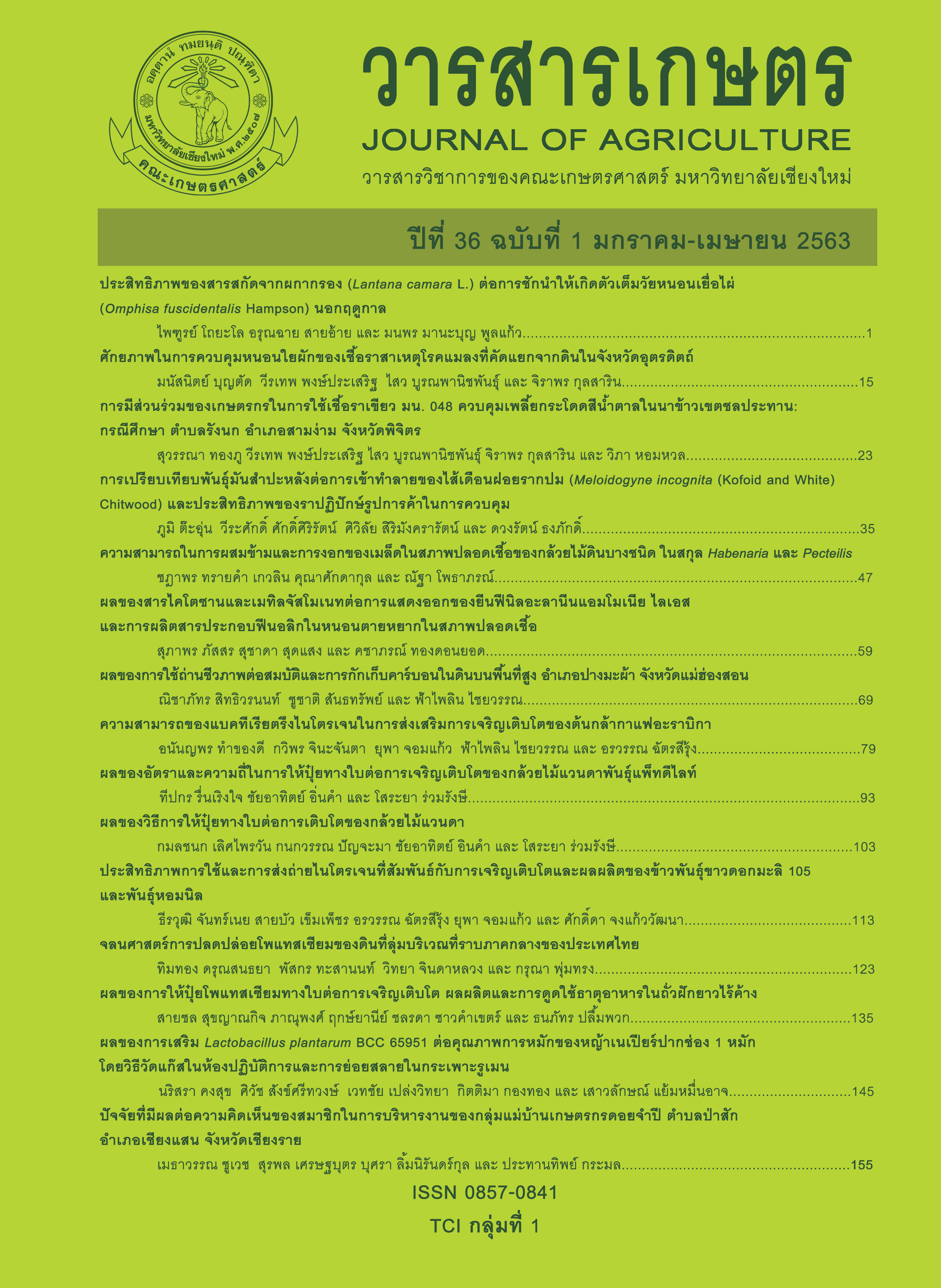Comparison of Cassava Varieties on Infection of Root-knot Nematode, <I>Meloidogyne incognita</I> (Kofoid and White) Chitwood and Efficiency of Commercial Products of Antagonistic Fungi for Controlling
Main Article Content
Abstract
Ten well-known varieties of cassava; (Rayong 5, 7, 9, 11, 13, 72 and 90, KU 50, Huay Bong 60 and 80) were tested on root-knot nematode Meloidogyne incognita (RKN) infection in greenhouse condition. The cassava plant was grown in the pot (Ø 15 cm), until 21 days after planting, the nematode egg suspension (3,000 eggs) was infested in the pot per plant. After 45 days of inoculation, the quantitative nematode parameters (number of gall/root system, number of eggs/g root, and number of female adults/g root) and also growth parameters, (shoot height, shoot and root fresh weight and root fresh weight), were evaluated. The result showed that Rayong 9 was the most susceptible variety to RKN. For the efficiency of 4 commercial products of antagonistic fungi (Beauveria bassiana, Paecilomyces lilacinus, Metarhizium anisopliae and Trichoderma harzianum) on control RKN of cassava variety Rayong 9 was investigated under greenhouse condition in comparison to using nematicide (carbosulfan) and control 1 (no use of the products or nematicide and inoculation with RKN egg suspension) and untreated cassava (control 2). The commercial products were applied using recommendation rates to the cassava plants in pots. After 7, 5, 3 and 0 days of fungal application, the RKN egg suspension was inoculated in the soil. The experiments were carried out in a greenhouse comprised 19 treatments, 4 replications in CRD. After 45 days of RKN inoculation, cassava plants were determined and evaluated on RKN and growth parameters. The result of the experiment (March 16th - May 1st, 2018) demonstrated that the 4 antagonistic products and carbosulfan were (P<0.05) effective on control RKN showing 60.35 - 276.80 egg masses/root system with gall reduction of 60.28 - 91.34% and better than control treatment (696.96 egg masses), even though on the application of 7, 5, 3 or 0 day before RKN inoculation. Especially, using T. harzianum at 7 days before RKN inoculation, gave rise to the lowest number of RKN parameters, compared to other treatments treated with RKN and showing the most reduction of gall 91.34%.
Article Details
References
Begum, K., N. Hasan, S. Khandker, F.M. Aminuzzaman, M. Asaduzzaman and N. Akhtar. 2014. Evaluation of brinjaI cultivars (Solanum melongena) against root-knot nematode Meloidogyne spp. Applied Science Reports 7(3): 129-134.
Byrd, D.W., T. Kirkpatrick and K.R. Barker. 1983. An improved technique for clearing and staining plant tissue for detection of nematodes. Journal of Nematology 15(1): 142-143.
Chupraphawan, Y., W. Saksirirat, A. Hiransalee and N. Sanaomuang. 2007. Evaluation of soil fungi for suppressing root-knot nematode Meloidogyne incognita of chilli in microplot trials. Khon Kaen Agriculture Journal 35(2): 189-195. (in Thai)
Coyne, D.L. 1994. Nematode pests of cassava. African Crop Science Journal 2(4): 355-359.
Ekanayake, H.M.R.K. and N.J. Jayasundara. 1994. Effect of Paecilomyces lilacinus and Beauveria bassiana in controlling Meloidogyne incognita on tomato in Sri Lanka. Nematologia Mediterranea 22: 87-88.
Greenfield, M., M.I. Gomez-Jimenez, V. Ortiz, F.E. Vega, M. Kramer and S. Parsa. 2016. Beauveria bassiana and Metarhizium anisopliae endophytically colonize cassava roots following soil drench inoculation. Biological Control 95: 40-48.
Kagoda, F., D. Coyne, C. Kajumba and J. Dusabe. 2004. Early screening of cassava for resistance to root knot nematodes. Uganda Journal of Agricultural Sciences 9: 574-577.
Lertsuchatavanich, U. 2015. Efficiency of chemical and bioproduct on controlling root-knot nematode of cassava. pp. 1-7. In: Proceedings of the 53rd Conference of Kasetsart University, Bangkok. (in Thai)
Maneechote, C., S. Sahaya, P. Ekkathin and Y. Anantanamanee (eds.). 2016. Handbook of Integrated Pest Management of Cassava. Guarantee Co., Bangkok. 67 p. (in Thai)
Martinez-Medina, A., I. Fernandez, G.B. Lok, M.J. Pozo, C.M.J. Pieterse and S.C.M. Van Wees. 2016. Shifting from priming of salicylic acid- to jasmonic acid-regulated defences by Trichoderma protects tomato against the root knot nematode Meloidogyne incognita. New Phytologist 213(3): 1363-1377.
Office of Expert, Department of Agriculture. 2019. Plant Pest. (Online). Available: http://www.expertdoa.com/km_plant_info.php?ProductID=16 (May 10, 2019). (in Thai)
Sahebani, N. and N. Hadavi. 2008. Biological control of the root knot nematode Meloidogyne javanica by Trichoderma harzianum. Soil Biology and Biochemistry 40(8): 2016-2020.
Saksirirat, W. 2017. Antagonistic Fungi for Biological Control of Plant Diseases. Klung Nana Partnership, Khon Kaen. 212 p. (in Thai)
Sharon, E., M. Bar-Eyal, I. Chet, A. Herrera-Estrella, O. Kleifeld and Y. Spiegel. 2001. Biological control of the root-knot nematode Meloidogyne javanica by Trichoderma harzianum. Phytopathology 91(7): 687-693.
Sonthirat, S., K. Suthisuk, W. Norasing, S. Ratchatha and C. Suwannasarn. 1978. Plant parasitic nematode in the northeast. Research Paper No.3, Agricultural Office of the Northeast, Khon Kaen. 50 p. (in Thai)
Tangchitsomkid, N., P. Mulchanta, U. Lertsuchatwanit and O. Boonseng. 2015. Selection and evaluation of cassava germ plasm resistant to root-knot nematode. Full Report. NSTDA, Bangkok. 69 p. (in Thai)
Tranier, M.-S., J. Pognant-Gros, R.D.C. Quiroz, C.N.A. Gonzalez, T. Mateille and S. Roussos. 2014. Commercial biological control agents targeted against plant-parasitic root-knot nematodes. Brazilian Archives of Biology and Technology 57(6): 831-841.
van Vuuren, R.J. and B. Woodward. 2001. The response of cassava cultivars to root-knot nematode infestation: an in vitro method. Euphytica 120(1): 109-113.


